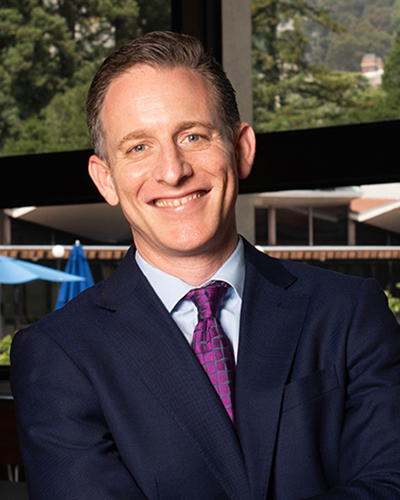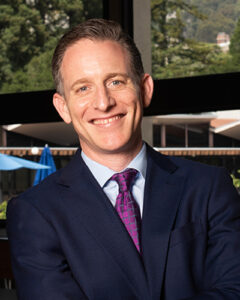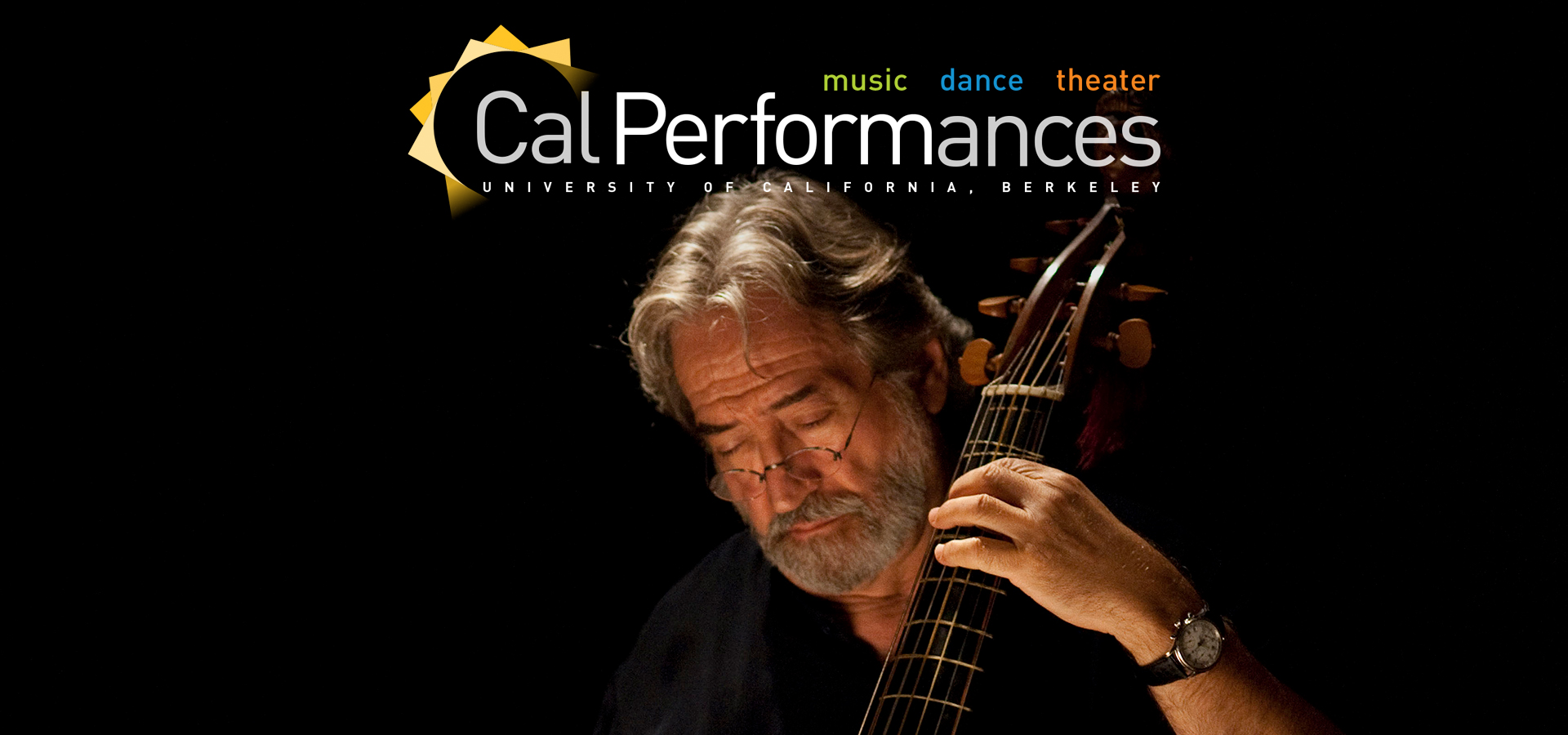Jordi Savall and Hespèrion XXI
Le Nuove Musiche: The Baroque Revolution (1560–1660)
Friday, April 12, 2024, 8pm
First Congregational Church, Berkeley
(also known as First Church)
With the support of the Departament de Cultura of the Generalitat de Catalunya and the consortium Institut Ramon Llull.
Major support for this performance is provided by The Bernard Osher Foundation.
Cal Performances is committed to fostering a welcoming, inclusive, and safe environment for all—one that honors our venues as places of respite, openness, and respect. Please see the Community Agreements section on our Policies page for more information.
This program will be performed without intermission and last approximately 75 minutes.
From the Executive and Artistic Director

As we enter the final weeks in Cal Performances’ 2023–24 season, it’s natural to take a look back and remember the highlights of a truly remarkable eight months at UC Berkeley. We will all have our favorite moments—instances when a performance seemed to leap off the stage and speak to us directly. But if such experiences are deeply personal, they also all depend on the communal act of gathering together and opening our eyes, ears, and hearts to the miracle of artistic expression. Every day throughout the world, people come to performances to celebrate what it means to be human in an increasingly impersonal world. As this particular season winds down, let me thank each and every one of you for taking part in the magic of great—and live!—music, theater, and dance.
Once again, April means one thing in particular at Cal Performances—Ailey Week—when the renowned Alvin Ailey American Dance Theater returns for its annual spring residency. With its relationship with UC Berkeley now in its 56th year (Ailey has visited campus every non-pandemic year since 1968), the company will present five separate programs from April 2 through April 7. The centerpiece of this year’s residency is the 2024 Gala on Thursday, April 4, with all proceeds benefiting Cal Performances’ artistic initiatives and education programs. During the week, we will also present an Ailey SchoolTime performance for K–12 students and provide an opportunity for alumni of Berkeley/Oakland AileyCamp to reconnect with company members. On opening night, Tuesday, April 2, I’m especially proud that Cal Performances will offer live audio descriptions and a pre-performance haptic tour for blind and visually impaired audience members.
As the season draws to a close in early May, we still have much to look forward to: gifted early-music artists like countertenor Jakub Józef Orliński with the acclaimed ensemble Il Pomo d’Oro (Apr 9) and Jordi Savall with Hespèrion XXI (Apr 12); the thunderous traditional taiko drumming of Drum Tao (Apr 11–12); superb chamber music with the Danish String Quartet and guest cellist Johannes Rostamo (Apr 13) and French ensemble Quatuor Ébène (Apr 16); a duo vocal recital with opera stars (and a husband-and-wife team to boot!) soprano Amina Edris and tenor Pene Pati, with Robert Mollicone at the piano (Apr 23); a highly anticipated return to campus by one of the most adventurous artists on the international pop music scene, the always astonishing Angélique Kidjo (Apr 26); astounding Icelandic pianist Víkingur Ólafsson in a special performance of J.S. Bach’s immortal Goldberg Variations (May 4); and an evening with America’s preeminent humor writer—and frequent guest of Cal Performances—David Sedaris (May 5).
And I must make special mention of the upcoming visit by our dear friends at the Mark Morris Dance Group (Apr 19–21), returning to their West Coast home away from home with a profoundly moving repertory work (2010’s Socrates) and the world premiere of a new Mark Morris creation, Via Dolorosa, set to Nico Muhly’s meditative composition The Street (performed live by harpist Parker Ramsay). In the more than 35 years since the company first appeared at UC Berkeley, Mark Morris’ dancers have treated Cal Performances audiences to the premieres of more than a dozen new Morris works, many of which have gone on to become company classics—don’t miss this chance to be part of dance history!
Finally, I hope you’ll join us on April 16, when we announce our extraordinary 2024–25 season. One major detail has already been announced—the Maria Manetti Shrem and Elizabeth Segerstrom California Orchestra Residency, when Cal Performances and the Philharmonic Society of Orange County will bring the world renowned Vienna Philharmonic and conductor Yannick Nézet-Séguin to California during spring 2025. And I can promise you many more welcome and exciting surprises when full season details are announced.
Again, thank you for joining us this season. I look forward to seeing you again in the fall.
Jeremy Geffen
Executive and Artistic Director, Cal Performances
 As we enter the final weeks in Cal Performances’ 2023–24 season, it’s natural to take a look back and remember the highlights of a truly remarkable eight months at UC Berkeley. We will all have our favorite moments—instances when a performance seemed to leap off the stage and speak to us directly. But if such experiences are deeply personal, they also all depend on the communal act of gathering together and opening our eyes, ears, and hearts to the miracle of artistic expression. Every day throughout the world, people come to performances to celebrate what it means to be human in an increasingly impersonal world. As this particular season winds down, let me thank each and every one of you for taking part in the magic of great—and live!—music, theater, and dance.
As we enter the final weeks in Cal Performances’ 2023–24 season, it’s natural to take a look back and remember the highlights of a truly remarkable eight months at UC Berkeley. We will all have our favorite moments—instances when a performance seemed to leap off the stage and speak to us directly. But if such experiences are deeply personal, they also all depend on the communal act of gathering together and opening our eyes, ears, and hearts to the miracle of artistic expression. Every day throughout the world, people come to performances to celebrate what it means to be human in an increasingly impersonal world. As this particular season winds down, let me thank each and every one of you for taking part in the magic of great—and live!—music, theater, and dance.
Once again, April means one thing in particular at Cal Performances—Ailey Week—when the renowned Alvin Ailey American Dance Theater returns for its annual spring residency. With its relationship with UC Berkeley now in its 56th year (Ailey has visited campus every non-pandemic year since 1968), the company will present five separate programs from April 2 through April 7. The centerpiece of this year’s residency is the 2024 Gala on Thursday, April 4, with all proceeds benefiting Cal Performances’ artistic initiatives and education programs. During the week, we will also present an Ailey SchoolTime performance for K–12 students and provide an opportunity for alumni of Berkeley/Oakland AileyCamp to reconnect with company members. On opening night, Tuesday, April 2, I’m especially proud that Cal Performances will offer live audio descriptions and a pre-performance haptic tour for blind and visually impaired audience members.
As the season draws to a close in early May, we still have much to look forward to: gifted early-music artists like countertenor Jakub Józef Orliński with the acclaimed ensemble Il Pomo d’Oro (Apr 9) and Jordi Savall with Hespèrion XXI (Apr 12); the thunderous traditional taiko drumming of Drum Tao (Apr 11–12); superb chamber music with the Danish String Quartet and guest cellist Johannes Rostamo (Apr 13) and French ensemble Quatuor Ébène (Apr 16); a duo vocal recital with opera stars (and a husband-and-wife team to boot!) soprano Amina Edris and tenor Pene Pati, with Robert Mollicone at the piano (Apr 23); a highly anticipated return to campus by one of the most adventurous artists on the international pop music scene, the always astonishing Angélique Kidjo (Apr 26); astounding Icelandic pianist Víkingur Ólafsson in a special performance of J.S. Bach’s immortal Goldberg Variations (May 4); and an evening with America’s preeminent humor writer—and frequent guest of Cal Performances—David Sedaris (May 5).
And I must make special mention of the upcoming visit by our dear friends at the Mark Morris Dance Group (Apr 19–21), returning to their West Coast home away from home with a profoundly moving repertory work (2010’s Socrates) and the world premiere of a new Mark Morris creation, Via Dolorosa, set to Nico Muhly’s meditative composition The Street (performed live by harpist Parker Ramsay). In the more than 35 years since the company first appeared at UC Berkeley, Mark Morris’ dancers have treated Cal Performances audiences to the premieres of more than a dozen new Morris works, many of which have gone on to become company classics—don’t miss this chance to be part of dance history!
Finally, I hope you’ll join us on April 16, when we announce our extraordinary 2024–25 season. One major detail has already been announced—the Maria Manetti Shrem and Elizabeth Segerstrom California Orchestra Residency, when Cal Performances and the Philharmonic Society of Orange County will bring the world renowned Vienna Philharmonic and conductor Yannick Nézet-Séguin to California during spring 2025. And I can promise you many more welcome and exciting surprises when full season details are announced.
Again, thank you for joining us this season. I look forward to seeing you again in the fall.
Jeremy Geffen
Executive and Artistic Director, Cal Performances
THE BAROQUE REVOLUTION
“The court of Europe”: this could be an alternative title for a program that offers an overview of great composers who lived in different European regions between the Renaissance and the Baroque, at a time when forms and compositional techniques of the 16th century coexisted with those of the new century—the “new music,” Monteverdi’s “second practice”—which also appeared in the world of instrumental music. This new music could be completely unknown or reappear like an old friend,who changes over time while maintaining characteristic features. Thus we find a series of dances that still partly refer to the Renaissance world alongside toccatas and fantasies decidedly in line with the new aesthetics.
Tonight’s program is ordered chronologically: we start from three Renaissance pieces collected in the first edition of Capricci in musica by Vincenzo Ruffo and here arranged as a small suite. Ruffo, from Verona with a musical career in Northern Italy, was appointed Maestro di Cappella of the Duomo of Milan in 1563, and the following year dedicated his collection of Capricci to Marc’Antonio Martinengo Marquis of Villachiara—partially to signal himself to the local nobles, voracious consumers of instrumental music. With La Gamba and La Disperata is also a piva, fast dance of popular origin that was already belonged to the context of the 15th-century dance and that, although apparently absent from the choreographic world of the 16th century, appears sporadically in instrumental music collections of the time.
The two selections by Emilio de’ Cavalieri are emblematic pieces: The first is part of a composition that is vying for the rights of primogeniture as compared to the “new music” then beginning to emerge. The second is notable for its incredible popularity; it belongs to the cycle of Intermedii that first appeared during a time of exceptional ferment and experimentation that will lead to the birth of the opera.
A well-known dance between the 16th and 17th centuries was the gagliarda, built on a basic scheme of five dance steps on six beats of music, which could also be varied choreographically in a very virtuosoc ways. It was usually preceded by a Pavane with a slower course and the character of a procession; the gagliarda was very popular both as a dance and in instrumental form. The Earle of Peembrookes Galiard, by the London composer and soldier Tobias Hume, is contained in the collection Poeticall Musicke (1607) together with Start; this collection constitutes the first repertoire composed for lyra viola (a kind of viola da gamba), the real protagonist of Hume’s songs. Other Gagliardes are proposed during the program with more specific connotations: the Battle of the German Samuel Scheidt and the Gallarda Napolitana by the blind Neapolitan Antonio Valente.
The famous anonymous song “Greensleeves to a Ground” reminds us of another element very present in the musical practice of the time throughout Europe, namely the composition on a basso ostinato (a ground, in English), on which the other parts propose a series of variations.
Continuing we will listen to the Ciaccona, whose presence is attested in Spain already at the end of the 16th century. Traditionally accompanied by guitars, tambourines, and castanets both in Spain and in Italy (especially in Naples) the Ciaccona was often introduced in theatrical performances of the commedia dell’arte. The Italian variant is more exuberant than the Spanish one; it has a faster time, and prefers greater shades. Andrea Falconiero will introduce us to a Ciaccona with three voices, in which the three instrumental parts launch into a passionate back-and-forth.
Another important musical form at this time is that of the canzona, a term that developed largely in Italy around the 17th century; it is described by Michael Praetorius as “a series of short fugues for ensembles of four, five, six, eight, or more parts, with a repetition of the first at the end.” Girolamo Frescobaldi dedicated himself on several occasions to this type of instrumental composition: the songs we will listen to this evening belong to the First Book of Songs, published in Rome in 1628. The edition was prepared and put into score by the composer’s pupil Bartolomeo Grassi who, as is explained in the afterword of the work, gave each of the 37 songs a dedicatory name inspired by the names of gentlemen from Lucca.
The viola da gamba, in different sizes and different combinations, is the protagonist this evening: the instrument, born around the 15th century, had great success due to its ability to express itself in consort, in homogeneous ensembles or mixed with different instruments, and as a soloist, pushed to levels of virtuosity; today’s program, in addition to demonstrating the musical richness of early 17th-century instrumental music, also makes clearl the different shades of the voice of the viola.
—Text by Francesca Pinna in collaboration with the Department of Musicology and Cultural Heritage, University of Pavia, Cremona campus



